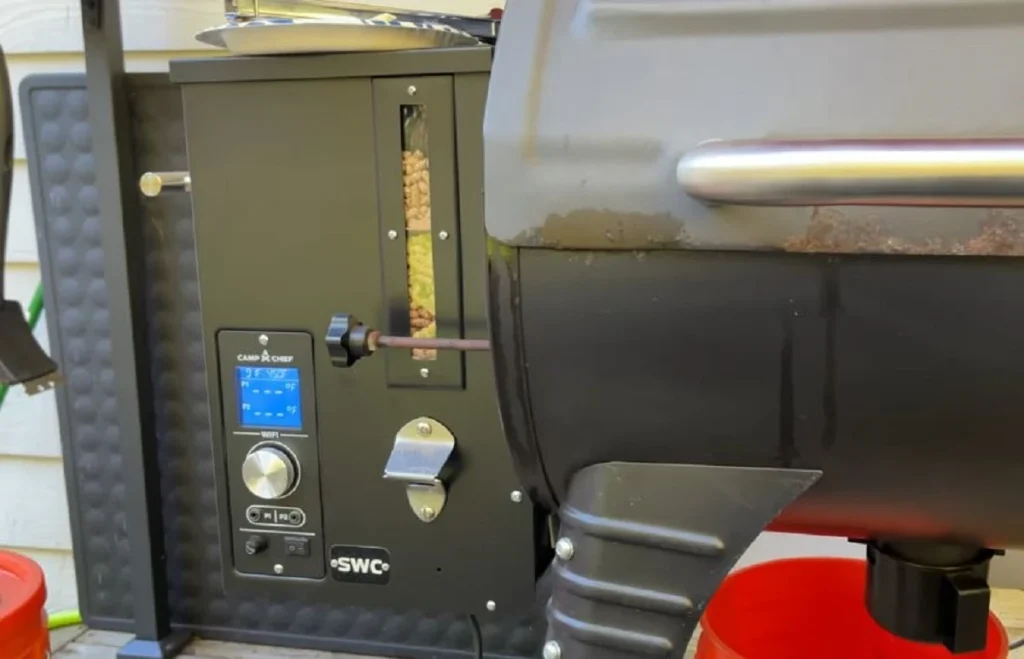| Note: This article may contain affiliate links, which means if you make a purchase following our links won’t cost you extra, but we may earn a commission. Learn more |
If your Camp Chef pellet grill is not heating up, several factors could be at play. Checking the chimney openness and adjusting it might solve the issue, especially on breezy days that impact temperature control. It’s also important to use Camp Chef pellets, as the quality and type of pellets can significantly influence the grill’s temperature.
When facing heating issues with your Camp Chef pellet grill, the first step is to ensure there are no obstructions in the airflow or pellet feed system. A common culprit is the fan not working properly, which is essential for maintaining the fire and temperature.
Another factor could be issues with the ignition system, including the igniter or hot rod, which are critical for starting the grill. If your grill won’t ignite, checking these components for damage or wear can help identify the problem.
Pellet quality is another key factor. Low-quality pellets might not burn as efficiently or may cause inconsistent temperatures. If your grill is not getting hot enough, switching to high-quality Camp Chef pellets can make a difference.
Environmental conditions like wind can cool the grill faster than it can heat, so positioning your grill to minimize wind exposure can help maintain the desired temperature.
For those experiencing a flame error or flame out, it’s important to ensure the pellet hopper is full and feeding pellets smoothly into the firepot. Sometimes, a simple reset or cleaning of the firepot can resolve these issues.
Troubleshooting the Ignition System of Camp Chef Pellet Grills
Experiencing issues with your Camp Chef pellet grill not heating up can often trace back to the ignition system. The heart of the problem typically involves the igniter or hot rod, components responsible for lighting the pellets. If these parts fail, the grill won’t heat up.
To diagnose, first check the power supply to ensure your grill is receiving electricity. Next, inspect the igniter and hot rod for damage or buildup of pellet dust, which can hinder their function.
Cleaning the burn pot regularly is also essential, as excessive ash can prevent the igniter from doing its job. For parts that are visibly worn or damaged, replacing them is often the most effective solution.
Remember, troubleshooting should always start with the simplest fixes, such as making sure the grill is plugged in and the circuit breaker hasn’t tripped.
5 Reasons for Camp Chef Pellet Grill Not Heating Up, and How to Fix Them
1. Power Supply and Electrical Connections
Faulty Power Supply: A common issue that prevents the grill from heating up is a disrupted power supply. Ensure the grill is plugged into a working outlet and check for any tripped circuit breakers or blown fuses.
Solution: Verify the power source with another device to confirm the outlet’s functionality. Reset any tripped circuit breakers and replace blown fuses if necessary. Ensuring a steady power supply restores the grill’s ability to heat up.
2. Faulty Ignition System
Igniter and Hot Rod Malfunction: The ignition system, specifically the igniter and hot rod, is crucial for starting the grill. Wear and tear or buildup of pellet dust can impede their functionality.
Solution: Inspect these components for visible damage or excessive ash buildup. Cleaning the burn pot and replacing worn parts are effective measures to fix the issue, restoring the grill’s heating capability.
3. Pellet Quality
Inferior Pellet Quality: Using low-quality or moist pellets can lead to inadequate heating. Poor-quality pellets may not burn efficiently, affecting the grill’s temperature.
Solution: Switch to high-quality, low-moisture pellets specifically designed for pellet grills. Storing pellets in a dry environment prevents moisture absorption, ensuring consistent burn and optimal heating.
4. Airflow Issues
Blocked Airflow: Proper airflow is essential for maintaining the flame and temperature. Ash accumulation in the burn pot or around the fan can restrict airflow, hindering the grill’s ability to heat.
Solution: Regular cleaning of the grill’s interior, especially the burn pot and fan area, ensures unrestricted airflow. This maintenance step significantly improves heating efficiency.
5. Thermostat Calibration
Incorrect Thermostat Readings: An incorrectly calibrated thermostat may provide false readings, leading to heating issues.
Solution: Recalibrating the thermostat according to the manufacturer’s instructions ensures accurate temperature control. In some cases, replacing the thermostat might be necessary to achieve precise temperature management.
Common Complaints and Solutions for Camp Chef Pellet Grills
Fan Functionality Issues: A non-operational fan can prevent your grill from reaching the desired temperatures. Ensure it’s free from obstructions and debris that could impair its movement.
Fluctuating Temperatures: Inconsistent heat is often due to external conditions or pellet quality. High-quality, low-moisture pellets are crucial for stable temperatures.
Ignition Failures: A grill that won’t ignite might have issues with its hot rod or igniter. Regular inspection for wear and ensuring a clean firebox can mitigate this problem.
Error Codes: Modern Camp Chef models display error codes for specific issues. Refer to your manual to decode these messages and address the underlying problems.

Essential Maintenance for Camp Chef Pellet Grills
Routine Cleaning: Keeping the grill clean, especially the burn pot, auger, and firebox, prevents ash buildup that could impede performance. This includes wiping down the interior surfaces and vacuuming out leftover ash.
Part Checks and Replacements: Inspect the igniter, hot rod, and fan periodically for signs of wear or damage. Early replacement can prevent unexpected failures during cooking sessions.
Pellet Management: Store your pellets in a dry, sealed container to avoid moisture, which can affect burning efficiency and, by extension, grill temperature.